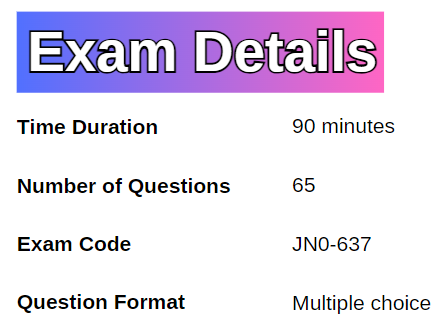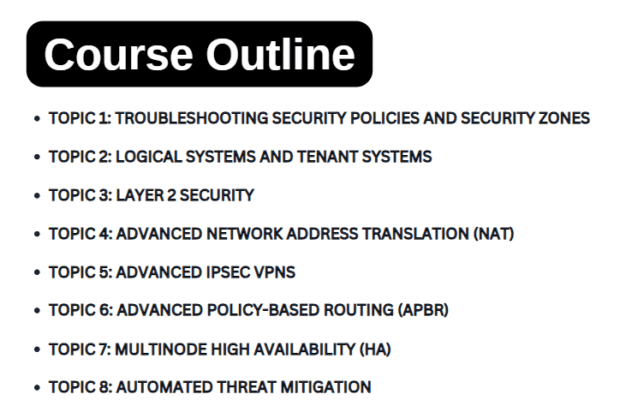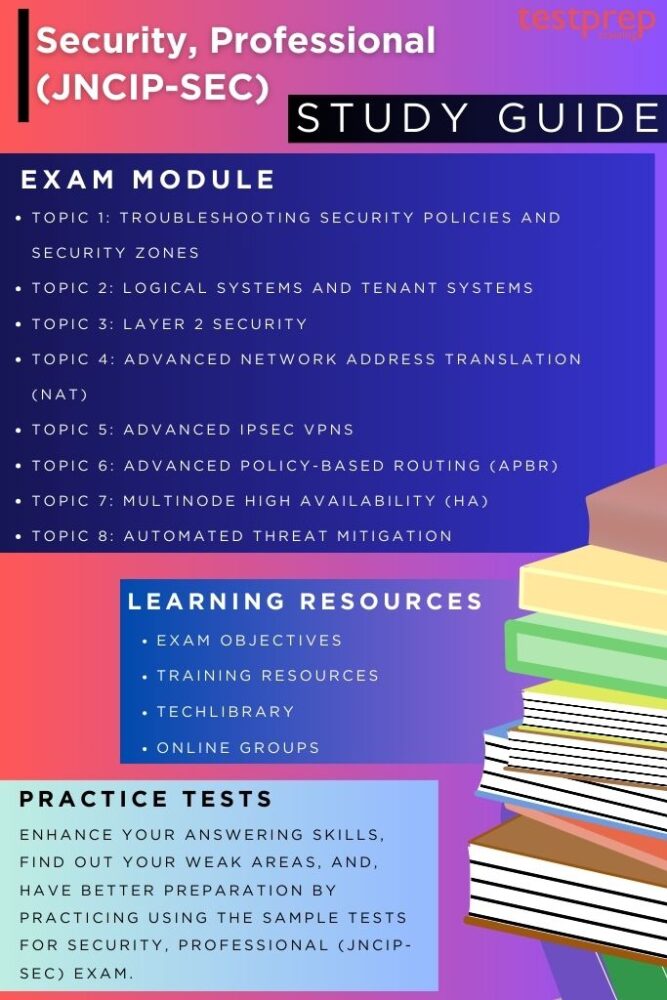Security, Professional (JNCIP-SEC)

The Security Track lets you showcase a comprehensive understanding of general security technologies and the Junos OS software for SRX Series devices. The Security, Professional (JNCIP-SEC) (JN0-637) certification, aimed at professionals with advanced expertise in Juniper Networks’ Junos OS for SRX Series devices, is the pinnacle of this track. This written exam assesses your knowledge of advanced security technologies, as well as your ability to configure and troubleshoot related platforms.
Exam Details

The Security, Professional (JNCIP-SEC) (JN0-637) certification exam has a prerequisite exam JNCIS-SEC, and is administered by Pearson VUE. It has a time limit of 90 minutes and consists of 65 multiple-choice questions. The exam uses the software version Junos OS 22.2 and SD 22.1.
Course Outline
The Security, Professional (JNCIP-SEC) (JN0-637) certification exam covers the following topics:

Topic 1: Troubleshooting Security Policies and Security Zones
Given a scenario, demonstrate how to troubleshoot or monitor security policies or security zones.
- Tools
- Logging or tracing
- Other outputs
Topic 2: Logical Systems and Tenant Systems
Describe the concepts, operations, or functionalities of logical systems.
- Administrative roles
- Security profiles
- Logical system communication
Describe the concepts, operations, or functionalities of tenant systems.
- Primary system and tenant system administrators
- Tenant system capacity
Topic 3: Layer 2 Security
Describe the concepts, operations, or functionalities of Layer 2 Security.
- Transparent mode
- Mixed mode
- Secure wire
- MACsec
- Ethernet VPN-Virtual Extensible LAN (EVPN-VXLAN) security
Given a scenario, demonstrate how to configure or monitor Layer 2 Security.
Topic 4: Advanced Network Address Translation (NAT)
Describe the concepts, operations, or functionalities of advanced NAT.
- Persistent NAT
- Domain Name System (DNS) doctoring
- IPv6 NAT
Given a scenario, demonstrate how to configure, troubleshoot, or monitor advanced NAT scenarios.
Topic 5: Advanced IPsec VPNs
Describe the concepts, operations, or functionalities of advanced IPsec VPNs.
- Hub-and-spoke VPNs
- Public Key Infrastructure (PKI)
- Auto discovery VPNs (ADVPNs)
- Routing with IPsec
- Overlapping IP addresses
- Dynamic gateways
- IPsec Class of Service (CoS)
Given a scenario, demonstrate how to configure, troubleshoot, or monitor advanced IPsec VPNs.
Topic 6: Advanced Policy-Based Routing (APBR)
Describe the concepts, operations, or functionalities of advanced policy-based routing.
- Profiles
- Policies
- Routing instances
- APBR options
Given a scenario, demonstrate how to configure or monitor advanced policy-based routing.
Topic 7: Multinode High Availability (HA)
Describe the concepts, operations, or functionalities of multinode HA.
- Concepts
- Chassis cluster versus multinode HA
- Deployment modes
- Services redundancy group (SRG)
- Interchassis link
- Active/active mode
- Active/passive mode
- Active node behavior (determination and enforcement)
Given a scenario, demonstrate how to configure or monitor multinode HA.
Topic 8: Automated Threat Mitigation
Describe the concepts, operations, or functionalities of Automated Threat Mitigation.
- Third-party or multicloud integration
- Secure Enterprise
Exam FAQs: Security, Professional (JNCIP-SEC) (JN0-637)
Exam General Guidelines
Juniper Networks has established recertification criteria to maintain the high standards of JNCP certifications and ensure the ongoing relevance of certified individuals’ skills. These criteria are applicable across all JNCP certification tracks and are subject to potential revisions.
- Renewing certifications can be achieved by either passing an exam or completing a course at a higher level within the same track. This renewal also extends to all lower-level active certifications within the track, as well as any other active Associate-level certifications.
- Program participants have access to their certification status through CertMetrics and will receive periodic email notifications concerning their certifications. It is the responsibility of certification holders to keep both their certifications and contact information current.
- All JNCP certifications remain active for three years. Failure to renew certifications within this three-year period will result in their expiration.
Study Guide for Security, Professional (JNCIP-SEC) (JN0-637)

1. Understand the Exam Objectives
Mastering the objectives of the Security, Professional (JNCIP-SEC) (JN0-637) exam is essential for effective preparation. These objectives detail the critical topics and skills that will be assessed, offering candidates a structured path for their studies. By familiarizing themselves with these objectives, candidates can identify areas needing extra focus, enabling them to devise a targeted study strategy and manage their time and resources efficiently. Furthermore, understanding these objectives helps candidates assess their readiness and confidence, ensuring comprehensive coverage of all required subjects and thorough preparation for the exam.
2. Use Juniper Recommended Training
This intensive four-day course equips students with the skills to configure and oversee advanced Junos OS security capabilities tailored for enterprise, campus, and service provider environments. Key subjects covered include advanced Junos OS security functionalities encompassing advanced reporting, next-generation Layer 2 security, advanced features for next-generation networks, security aspects of Ethernet VPN (EVPN) Virtual Extensible LAN (VXLAN), advanced policy-based routing, virtualization functionalities, advanced IPsec VPNs, advanced Network Address Translation (NAT) capabilities, and multinode high availability solutions. Through hands-on labs and demonstrations, students will gain practical experience with SRX Series devices and vSRX Series devices. This course is built upon Junos OS Release 23.2.
3. Use Juniper TechLibrary for Reference
Juniper TechLibrary is crucial for becoming proficient in Juniper Networks technologies. This resource-rich library provides a wide array of technical documentation, guides, configuration examples, and troubleshooting resources tailored for Juniper products and solutions. By exploring the TechLibrary, users can grasp the intricacies of Juniper devices and software, including their functionalities, configurations, and optimal practices. Navigating through this repository allows individuals to locate documentation that aligns with their particular interests or areas of expertise, whether it pertains to routing, switching, security, automation, or cloud solutions.
4. Join Study Groups
Engaging in study groups or communities presents a valuable chance to enhance your learning journey significantly. When you join groups aligned with your interests or certification objectives, you actively participate in discussions, share insights, and collaborate with peers. This interaction allows you to benefit from a diverse range of perspectives and expertise offered by fellow members. Moreover, these communities cultivate a supportive environment where individuals collaborate, motivate, and mentor each other, fostering collective growth and understanding.
5. Take Practice Tests
Practicing exam tests is incredibly beneficial as it helps identify your strengths and areas needing improvement. This self-assessment enhances your ability to answer questions efficiently and improves your time management skills for the real exam. It’s recommended to take these tests after covering each topic to solidify your grasp of the study materials. Regular practice tests also familiarize you with the exam structure and question types, reducing stress and boosting confidence. By systematically reviewing your performance in these tests, you can create a focused study strategy that targets your weaknesses and optimizes your preparedness for the exam.



